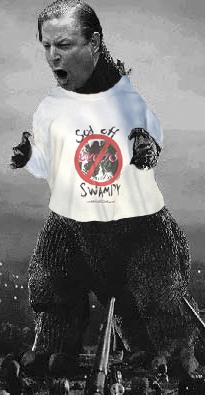Chill Out
I love a logical, calm discussion.
All eyes are on Greenland’s melting glaciers as alarm about global warming spreads. This year, delegations of U.S. and European politicians have made pilgrimages to the fastest-moving glacier at Ilulissat, where they declare that they see climate change unfolding before their eyes.
Curiously, something that’s rarely mentioned is that temperatures in Greenland were higher in 1941 than they are today. Or that melt rates around Ilulissat were faster in the early part of the past century, according to a new study. And while the delegations first fly into Kangerlussuaq, about 100 miles to the south, they all change planes to go straight to Ilulissat — perhaps because the Kangerlussuaq glacier is inconveniently growing.

A Swill salute to Powerline.

Willful iggerance is a wonderful thing, huh?
temperatures in Greenland were higher in 1941 than they are today
melt rates around Ilulissat were faster in the early part of the past century
Kangerlussuaq glacier is inconveniently growing
Hmm. A few more Inconvenient Truths?
They’ve got to hate hearing that. And things like:
The Gorebal lobby has the information outlets so sewn up that you never get to hear the contrary evidence unless you stumble across a piece like this. THAT’S the real travesty.
Not to mention… didn’t the place get it’s name “Greenland” from once being, you know, green? That is, back during the Medieval Warm period when it was settled by Vikings, who drove their gas-guzzling longboats all over the place.
Argh…. “its name” — I hate misused apostrophes…
Indeed, Andrea. People rarely cheerfully name exotic, ice covered wastelands they discover because they WISH it were warm, green and accommodating.
Just a note ~ we were in the high ’80’s yesterday. Gruesome for October, granted, but not even close to the record temp for the day of 95. Set in 1884, no less.
I want to know just WTF they were doing back then.
Actually, it’s been well documented that Greenland was given its name precisely because it wasn’t Green. It was a bit of a real estate ruse to convince settlers to join Erik the Red in the new land. Essentially, Erik was run out of town and chose to move west. He found Greenland and tried to make his own little colony there by snookering people into moving out there with him.
Iceland has always been much greener and Greenland was always mostly covered in glaciers. Iceland got its name simply because it stuck. It was also called Smokey land, Foggy land, and a few others that I don’t recall from my “host nation” classes when I lived there from 75 to 77.
From Wikipedia: “Data obtained from ice cores indicate that between AD 800 and 1300 the regions around the fjords of the southern part of the island experienced a relatively mild climate similar to today. Trees and herbaceous plants grew in the south of the island and the prevailing climate initially permitted farming of domestic livestock species as farmed in Norway.”
More from Wiki: “The name Greenland comes from Scandinavian settlers. In the Icelandic sagas, it is said that Norwegian-born Erik the Red was exiled from Iceland for murder. He, along with his extended family and thralls, set out in ships to find the land that was rumoured to be to the northwest. After settling there, he named the land Grænland (“Greenland”), possibly in order to attract more people to settle there. Greenland was also called Gruntland (“Ground-land”) and Engronelant (or Engroneland) on early maps. Whether green is an erroneous transcription of grunt (“ground”), which refers to shallow bays, or vice versa, is not known. It should also be noted, however, that the southern portion of Greenland (not covered by glacier) is indeed very green in the summer, and was likely even greener in Erik’s time because of the Medieval Warm Period.”